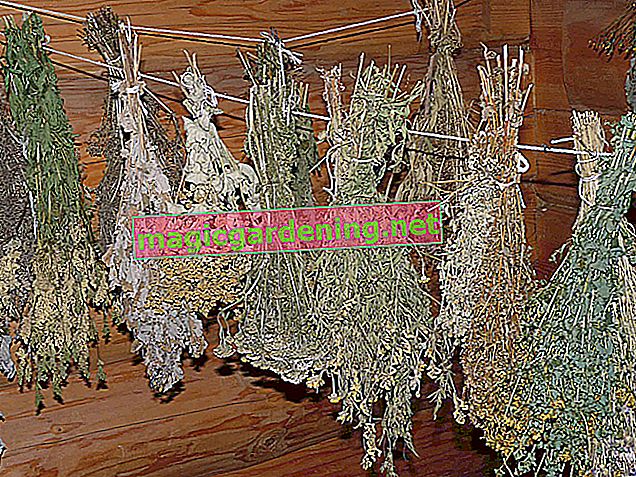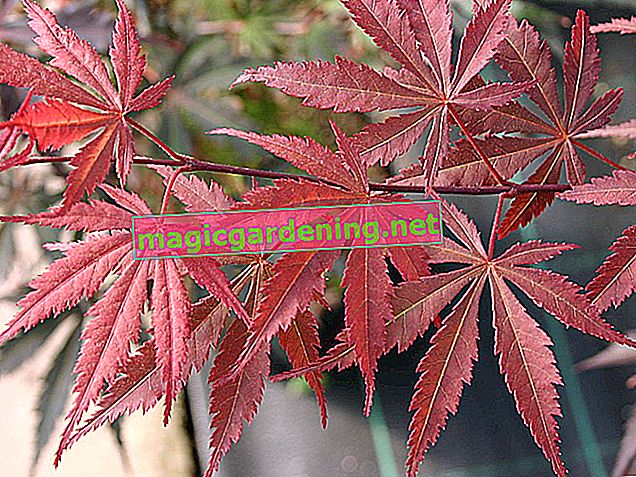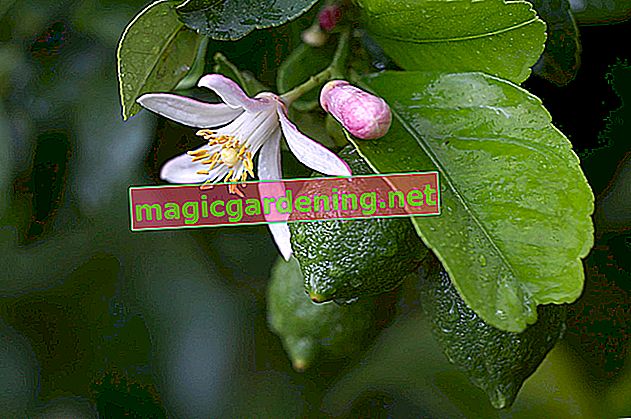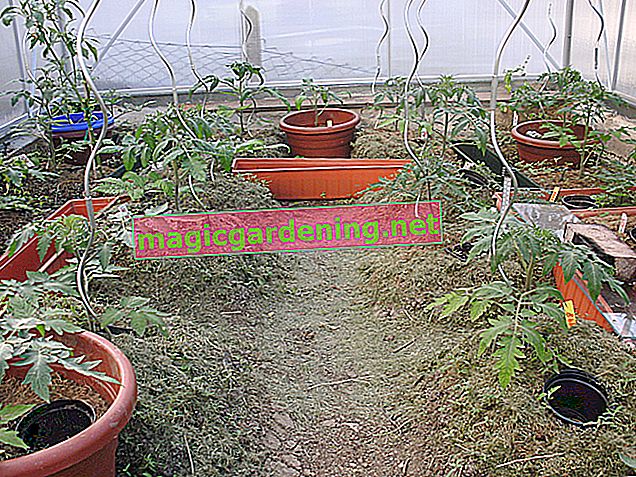
the essentials in brief
- Hedgehogs reveal their existence through holes in the lawn, droppings and evening sniffing noises
- A hedgehog should only be cared for if it really needs help, i.e. sick or very emaciated
- Hedgehogs can be fed cat food, fruit, scrambled eggs, or oatmeal
- If you leave dead wood and leaves lying around in autumn, you can offer hedgehogs winter quarters
Evidence of hedgehogs in the garden
In autumn, nocturnal hedgehogs venture out of cover for a short time, even during the day. Now the animal calendar is full of important preparations for the winter. Fat reserves have to be fed up and a cozy quarter for hibernation is not ready for occupancy overnight. At this time of year there are the best chances to watch the cute spiked bearers live in the garden during the day.
also read
- This is how hedgehogs overwinter in your garden - tips for the right winter quarters
- How is the garden safe for dogs? - Tips for the dog-friendly garden
- Squirrel Kobel in the garden - tips and interesting facts
For the rest of the year, gardeners have to rely on the following evidence to determine whether the demanding beneficial insects reward all efforts to create a natural garden with their hoped-for presence.
- Solution in the garden : excrement 2-5 cm long, firm, pencil-thick, strong odor
- Holes in the garden : 2 cm indentations in the lawn or bed
- Sniffing noises in the evening : audible sniffing of the sharp nose in the quiet, dark garden
In order to obtain final certainty about the presence of hedgehogs in the garden, inquisitive gardeners become hobby trackers. Hedgehog feet leave unmistakable traces on damp earth or in the snow. The sole walkers have 5 toes each on the front and rear feet, whereby the innermost toe is not always easy to recognize as a thumbprint. A foot is approximately 28 mm wide and 25 mm long. The picture below shows typical hedgehog tracks.

Hedgehog found - what to do?
At first glance, the joy is great when a hedgehog is found in the garden on the way or at home. The excitement about the unexpected encounter is quickly joined by uncertainty: Is the hedgehog in distress? Is he okay or does he need my help? Not all hedgehogs found are dependent on human support. Clear features indicate when you should really help a hedgehog. The following information briefly describes how to identify hedgehogs in need of help:
- Emaciated body : elongated figure, sunken flanks, long-legged gait, sunken eyes
- Makes strange noises : coughs or gasps
- Abnormal movements : staggering, limping, not moving or hardly moving
- Injuries : visible injuries, bloody spots
- Young animal : found during the day, eyes closed, orphaned
Do you have any suspicions that it is a sick or injured hedgehog? Then carefully pick up the animal with a cloth or gloves and turn it on its back. If the hedgehog does not immediately curl up into a ball and its stomach feels much colder than your hand, it is missing something. There is an urgent need for action. How to do it correctly:
- Note the location and time of discovery
- Lay out a cardboard tile with newspaper
- Put the suffering hedgehog in it
- Transport to the nearest vet
If the veterinary practice currently has no consultation hours, please contact a hedgehog care station.
Care for a hedgehog found - this is how it works
Under certain circumstances it may be necessary that you have to take a hedgehog to you overnight. As a transition area, pad the largest possible cardboard box with newspaper. A slightly smaller box acts as a nest. Torn kitchen paper or newspaper are well suited as nest material. Cut a hole in each box for entry and exit. You should ideally place both boxes in the bathtub. Finally, fill two shallow bowls with fresh water (no milk) and cat food.
With the help of the food provided, you can assess whether the hedgehog is sick or starving. A sick animal does not touch the food. A young, small hedgehog weighing 500 grams consumes around 150 grams of wet food within a day. An adult hedgehog weighing around 1000 grams has eaten 200 grams of wet food by the next day.
This information is helpful for the veterinarian or staff at a hedgehog care station for expert care of the prickly boulder.

Warm up hypothermic hedgehogs
The time it was found in winter and a noticeably cold hedgehog belly indicate hypothermia. Before going to other relief measures, the animal must urgently be warmed up. Fill a hot water bottle with lukewarm water. Place the hedgehog on it and give it a lot of rest.
An injured and sick hedgehog belongs immediately to the care of a veterinarian.
Feeding hedgehogs properly - tips for the menu
In spring and summer, nature has set the table for hungry hedgehogs. Lush plant growth goes hand in hand with myriads of insects and worms, which insectivores really appreciate. Feeding during the growing season is unnecessary, harmful and counterproductive. This does not apply to acute emergency situations in early spring or late autumn after an unexpected onset of winter. Help emaciated hedgehogs by setting up feeding stations in the garden. The following table compares which food is suitable for small hedgehog stomachs and what should not be on the plate:
| Suitable hedgehog food | Indestructible for hedgehogs |
|---|---|
| Dry hedgehog feed | milk |
| cat food | Yogurt, quark and similar dairy foods |
| oatmeal | All kinds of fruit |
| Wheat bran | raw beef, pork or poultry meat |
| unsalted peanuts | Canned dog food with lots of sauce |
| scrambled eggs | |
| unseasoned, fried minced meat |
As long as there is a food shortage in the wild, provide the recommended feed. Small hedgehog hearts beat faster when you combine the various ingredients in a tasty way. A combination of 100 grams of canned cat food, 2 tablespoons of oat flakes or dry hedgehog food and 1 tablespoon of scrambled eggs, prepared with a little sunflower oil, is very popular with prickly gourmets.
Please offer the food on a flat plate or coaster. Choose the location so that the feeding station is protected from other animals. Don't forget to give water to hungry guests. For this purpose, add a shallow bowl of fresh water, which you change daily. On this occasion, the entire feeding area is thoroughly cleaned to protect against mold, rot and parasites.
Hedgehogs - good or bad for the garden?
If there is evidence of hedgehogs frolicking in the garden, their presence is a headache for inexperienced gardeners. The question arises as to whether hedgehogs have a positive or negative influence on the cultivation of ornamental and useful plants. The focus is on the fear of damage, especially with a view of numerous holes in beds and lawns. At this point we can give the all-clear. This is why hedgehogs are a blessing for every garden:
- Pests eaters: Hedgehogs primarily eat plant-damaging insects, beetles, caterpillars, grubs and worms
- Aerators : in search of prey lace hedgehog noses loosen the soil in a wonderfully
- Garden police : Carrion does not stay long in the hedgehog area
A look at their menu shows that hedgehogs are not vegetarians. The lovable garden dwellers do not eat fruit, vegetables or flowers. When a hedgehog devotes itself to windfalls, it is targeting the larvae and caterpillars in it.
background
Function of the spines
Spikes act as a defensive weapon. A hedgehog has an average of 8,000 pointed, black and white spines available for the characteristic 'hedgehog'. If there is danger from predators such as dogs, cats, martens or foxes, the harried hedgehog will curl up into a ball with spikes. For the sensitive snouts of the aggressors, this clever defense strategy is reason enough to run away as quickly as possible.Settle prickly beneficial insects - this is how it works

The fundamental importance of hedgehogs in the garden, coupled with their irresistible charm, arouses the gardener's desire to settle the prickly beneficial insects. So that the shy night owls feel in good hands, important criteria of the natural garden design are important, which perfectly simulate the natural habitat of the native mammals.
Hedgehogs prefer to roam through slightly overgrown, richly structured green spaces such as orchards, cemeteries and house gardens in search of safe retreats. They feel at home wherever there is a rich supply of food, as well as a refuge for the rearing of the young and an undisturbed hibernation. The following table summarizes what belongs in a hedgehog-friendly garden and what doesn't:
| Inviting components | Disgusting components |
|---|---|
| dense hedge made from native deciduous trees | Concrete wall or chain link fence (€ 119.00 at Amazon *) as a fence |
| Dry stone wall with flowering plants | sealed garden areas |
| Pile of leaves, piles of stones with cavities | meticulously tidy beds |
| Pile of dead wood or benjes hedge | Use of pesticides |
| Hedgehog house (built yourself or bought ready-made) | few flowering perennials and woody plants |
| rotten wood as a source of insects | Gravel beds and rock gardens |
| Fruit trees with windfalls rich in insects | |
| open grass areas with worms and white grubs | |
| barrier-free property access | |
| Feeding places when food is scarce |
The more natural food sources a garden has to offer, the faster hedgehogs will settle in it. Wherever insects, larvae and earwigs frolic in flocks, the preyed on spiny animals are not far away.
Tips
As a prologue for the hedgehog-friendly garden, we recommend creating a heap of leaves for hedgehogs. On a base area of 2 mx 2 m, stack branches or split timber so that a cavity of 30 cm x 30 cm x 30 cm is created. This cavity is covered with a large amount of autumn leaves and fixed with coniferous twigs or fir fronds.
Courting encouraged - catching prohibited
In view of the beneficial benefits, please do not be tempted to capture and breed hedgehogs in order to keep beneficial insects in the garden. As an endangered species, hedgehogs are subject to the Nature Conservation Act. It is strictly forbidden to disturb or even catch the industrious insectivores. However, nothing speaks against advertising your visit with hedgehog-friendly garden design.
Digression
Beware of fleas!
Hedgehogs have fleas in their luggage. Not only moles, birds or mice carry fleas with them as stowaways. Hedgehogs are also among the main hosts of annoying pests. To prevent fleas from spreading through hedgehogs in the garden, you should thoroughly clean a hedgehog house at least twice a year: in spring when hedgehogs have left their winter quarters and in autumn when the hedgehog kindergarten is closed and winter is not far away. As a precaution, do not dispose of the nesting material on the compost, but in the garbage can.frequently asked Questions
The whole family is sad because we found a dead hedgehog in the garden. How should a dead hedgehog be disposed of?
Hedgehogs are small animals and can be buried in the garden without special permission. As an alternative, you can hand in the carcass at the regional animal disposal center. Not very respectful, but disposal in the organic waste bin is permitted. Please note in this context that the disposal of deceased animals in the residual waste is punishable by a fine as an administrative offense.
How do hedgehogs overwinter in the garden?
In order for hedgehogs to survive the lack of food during the winter, they hibernate from November to April. As winter quarters, the mammals look for a safe shelter in late autumn and convert it into a temperature-insulated, well-padded nest. However, many hedgehogs face housing shortages before winter because their natural habitats are shrinking and hedgehog-friendly gardens are in short supply. You can help the afflicted beneficial insects by creating piles of leaves and wood as retreats in the garden. The premium solution for the winter housing shortage is a cat-safe hedgehog house, either a homemade brand or from a specialist retailer.
How long do hedgehogs stay in the garden?
Hedgehogs are wild animals that are true to their location. Wherever the insectivores like it, they stay for a lifetime. Life expectancy is between 3 and 7 years, depending on the hazardous situation at the location. Unfortunately, there is a high death rate among baby hedgehogs. Up to 75 percent of young hedgehogs do not reach their first birthday.
How do I know if a hedgehog is sleeping or has died in the garden?
It is not uncommon for gardeners to come across sleeping hedgehogs while caring for plants. The hard-working insectivores are nocturnal and sleep during the day. With regular breathing movements, you can tell from spring to autumn that it is a sleeping hedgehog. It becomes more difficult when the barbed animal hibernates. From November to April hedgehogs curl up in a ball and only breathe very shallowly and barely noticeably 3 to 4 times per minute. In contrast to the sleeping hedgehog, a deceased animal lies open and has no longer curled up.
Tips
The Federal Association of Reservists in Germany honors outstanding publications on the topic of the Bundeswehr with the Golden Hedgehog Media Prize. At the beginning of the 1990s, the gold-colored logo was chosen because the hedgehog has stood for the values of peacefulness and defensiveness since ancient times. In this way the award motto 'Democracy has to be defensive' is skilfully illustrated.








